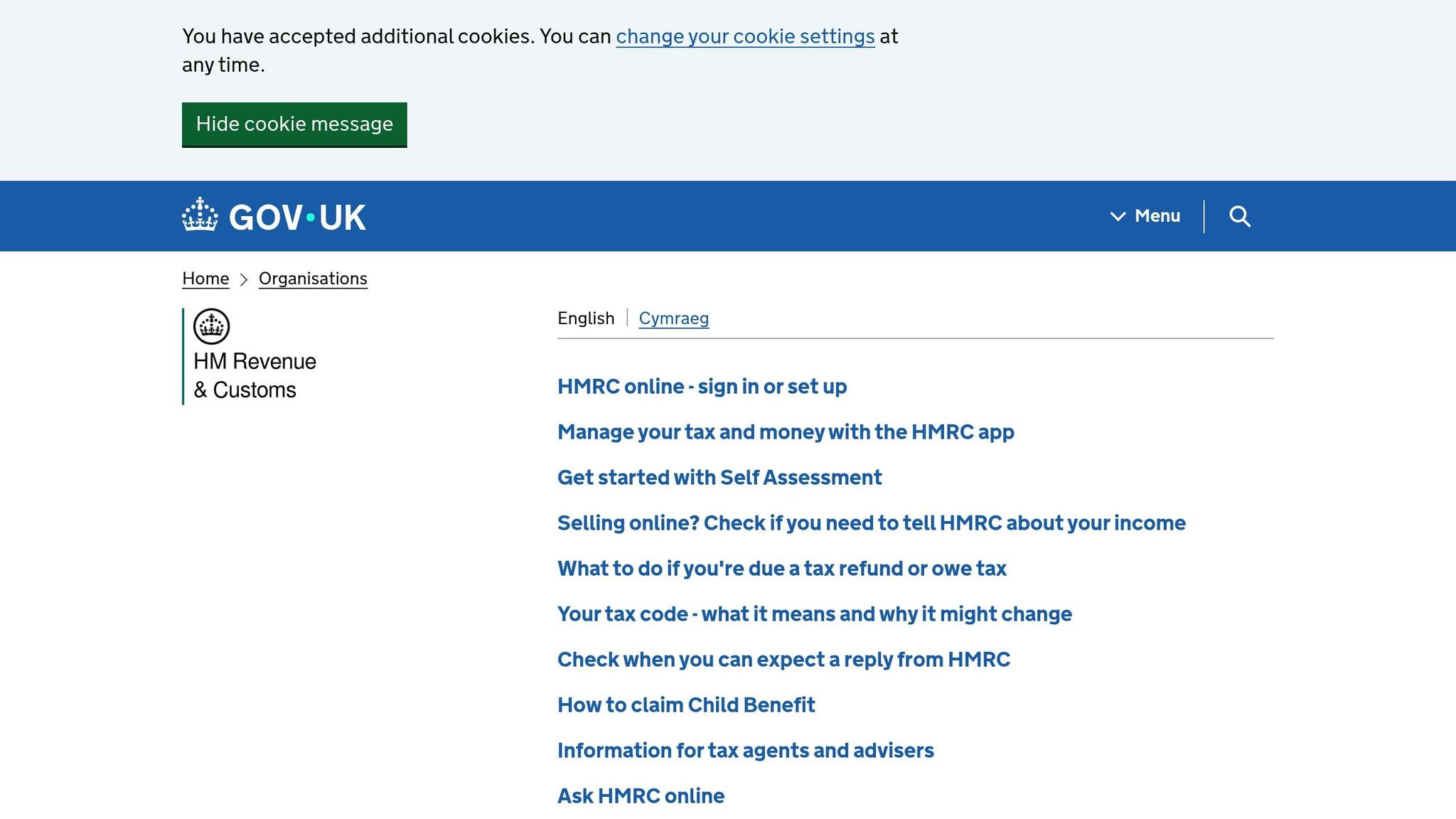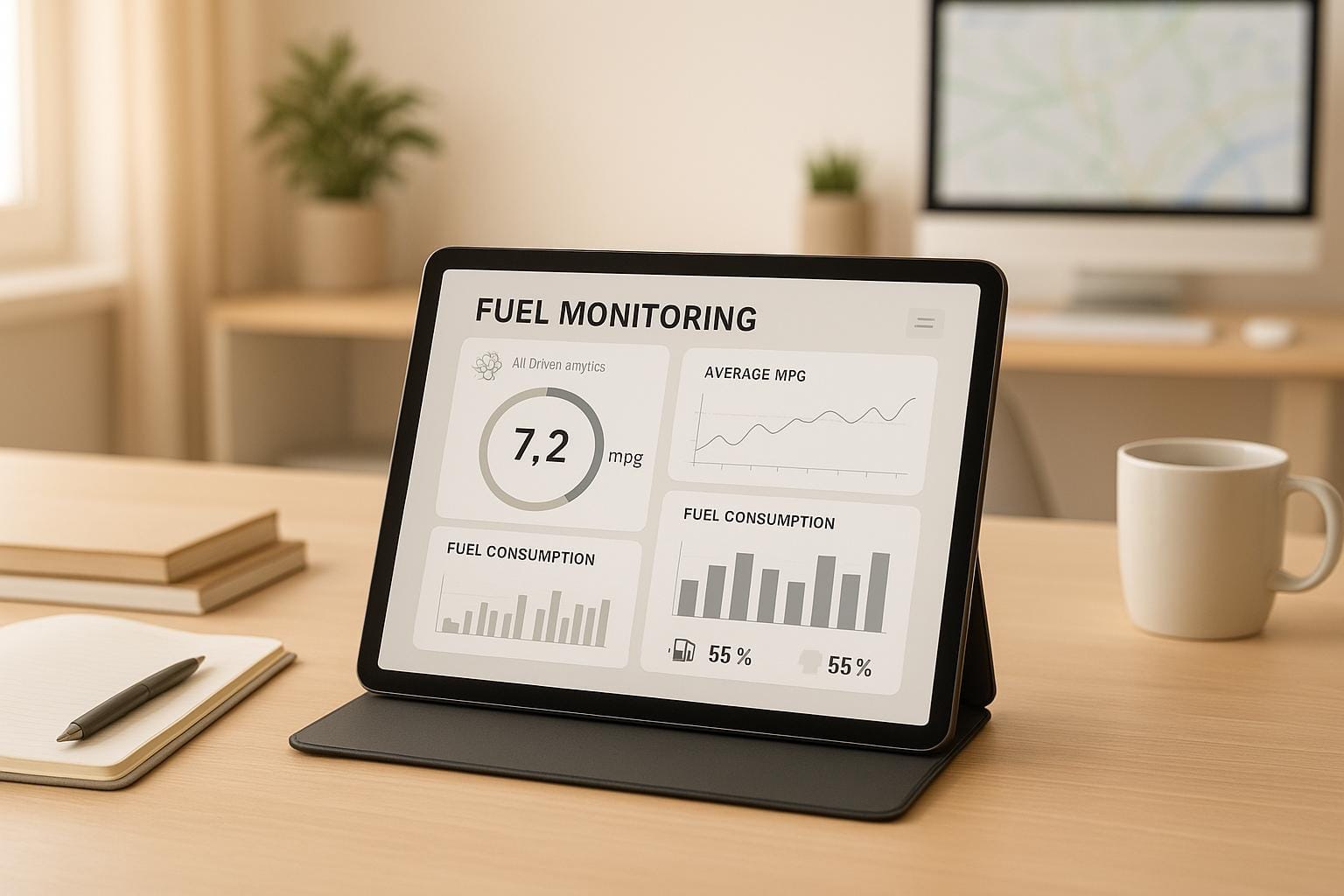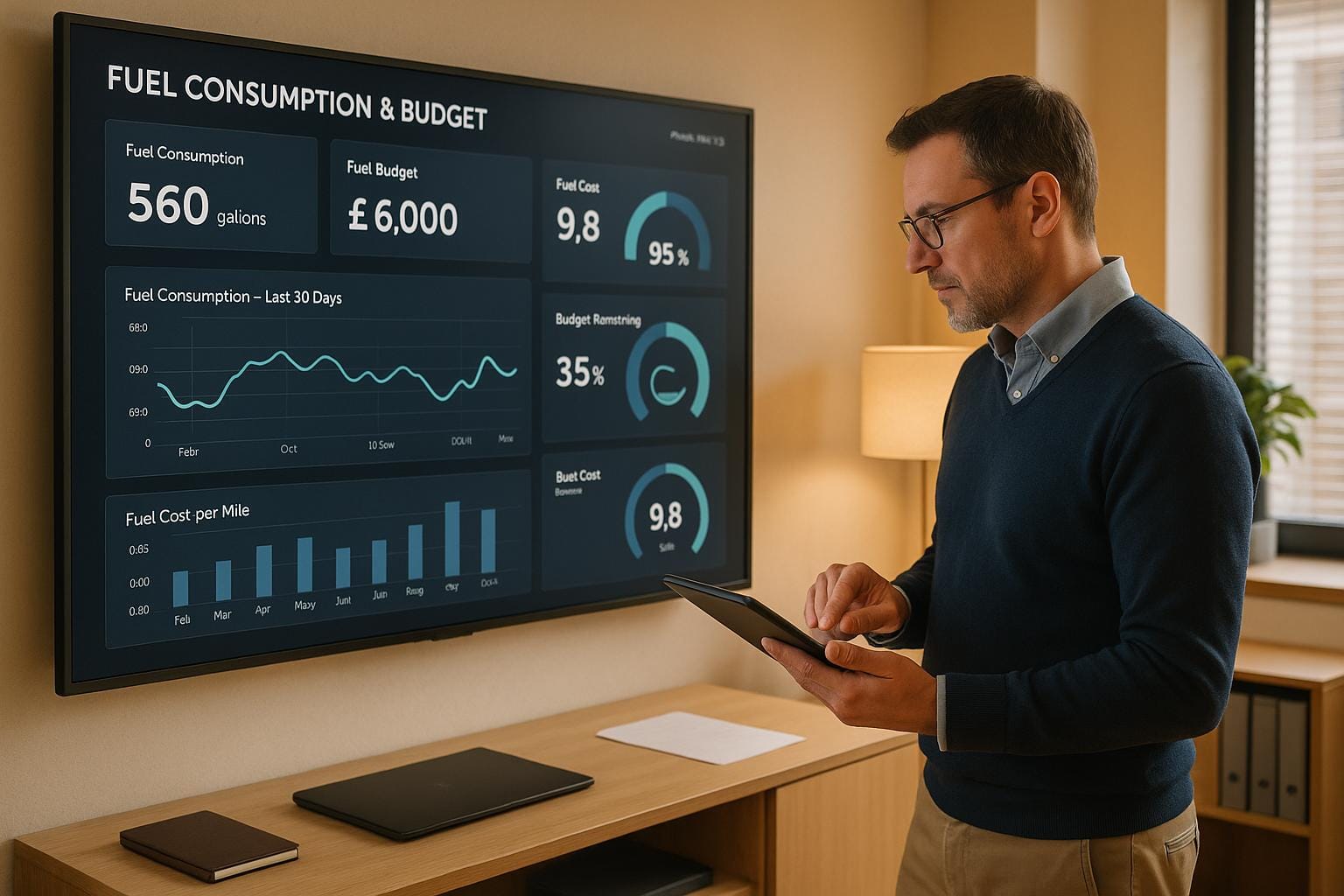AI fuel monitoring tools can help UK fleet managers cut costs, improve efficiency, and ensure compliance with regulations like HMRC mileage reporting. These systems track fuel consumption, detect theft, and flag inefficient driving habits in real time. Choosing the right system requires careful evaluation to avoid wasted investments.
Here’s what to focus on:
- Compatibility: Ensure the tool integrates with your fleet’s telematics, hardware (e.g., OBD2, CAN bus), and mixed vehicle types.
- Data Security: Look for GDPR compliance, encryption, and secure data handling practices.
- Scalability: Select a system that supports fleet growth and integrates with emerging technologies like EV tools.
- Key Features: Prioritise real-time tracking, fraud detection, HMRC-compliant mileage logs, and dual-tracker security.
- Support: Opt for UK-based customer service with clear installation and training resources.
Pro Tip: Test systems for live performance, alert accuracy, and compliance features before committing.
Fuel Monitoring System | Fuel Management Software | Fleet Management Software | fleetx
What to Consider Before Choosing AI Fuel Monitoring Tools
Fleet managers need to focus on three key areas to avoid potential issues with integration, compliance, and scalability. These factors form the basis for a solid evaluation checklist.
Fleet Telematics System Compatibility
Start by ensuring that your current telematics setup works seamlessly with the AI system you’re considering. The AI tool should integrate smoothly with your existing hardware and software.
It’s important that the system connects with your fleet’s devices - such as GPS units, ELDs, in-vehicle cameras, fuel flowmeters, and fuel level sensors. This helps to avoid duplicate hardware and ensures smoother operations.
Pay close attention to standard vehicle diagnostic interfaces. Systems that support OBD2 and J1939/CAN bus protocols are particularly valuable, as these are widely used across commercial vehicles. These interfaces allow the AI system to access critical engine data, fuel consumption details, and diagnostics directly from your onboard computers.
If your fleet includes a mix of vehicle types, make sure the system can handle this diversity. Compatibility with standard diagnostic protocols ensures consistent performance across various vehicles.
Data Security and GDPR Compliance
Data protection is a priority, so confirm that the system complies with GDPR requirements. It should encrypt sensitive information - such as vehicle locations, driver behaviour, and fuel usage - both during transmission and storage.
The system should also provide clear documentation on data handling practices, including retention policies, access rights, and processing methods. Additionally, it should outline procedures for switching providers. By supporting GDPR rights for both your company and its drivers, the system helps establish a strong framework for data security.
Take note of international data transfers as well. If the system processes data in facilities outside the UK or EU, it could create compliance challenges under UK data protection laws. Choosing a solution that manages data within the UK or EU makes it easier to meet these regulations.
Driver privacy is another critical factor. Look for features like data anonymisation or consent options for specific monitoring activities. These tools help you balance operational insights with respect for driver privacy.
Scalability and Flexibility
With telematics adoption growing rapidly in the UK, scalable solutions are essential. Your AI fuel monitoring system should not only meet your current requirements but also expand effortlessly as your fleet grows.
Flexibility for fleet size is a must. Whether you operate a small fleet or a large one, the system should maintain reliable performance even as data volumes increase.
The system should also integrate with emerging technologies, such as ADAS (Advanced Driver Assistance Systems), DMS (Driver Monitoring Systems), and EV management tools, ensuring it remains relevant as your needs evolve.
Regulatory adaptability is another key consideration for UK operators. The system should comply with current UK regulations, such as DVSA reporting, UK mapping standards, and tax calculations. It should also be prepared for future requirements, like the 2030 Zero Emission Vehicle Mandate.
Finally, think about your business’s future scenarios. The system should accommodate different vehicle types, operational workflows, and reporting needs without requiring a complete overhaul. Opt for an enterprise-grade platform that supports long-term growth and offers options like white-labelled or localised versions tailored to UK-specific needs. This approach ensures your system stays aligned with sustainability goals and operational precision.
Step-by-Step Checklist for Evaluating AI Fuel Monitoring Tools
Now that you’ve identified your needs for compatibility, compliance, and scalability, this checklist will help you systematically evaluate AI fuel monitoring solutions.
Check Real-Time Fuel Usage Tracking Features
Start by examining the system’s ability to monitor fuel usage in real time. Request a demo that uses live fuel consumption data to see how the system performs under actual conditions. The fuel usage should be displayed in appropriate units (like litres per 100 kilometres) and update quickly as conditions change.
Ensure the system integrates seamlessly with your existing fuel sensors and provides instant updates during refuelling. Look into how it handles historical fuel data - does it store records for a long enough period and present them in clear, visual formats? Features that allow you to analyse data by driver, route, vehicle type, or time period can be invaluable for identifying inefficiencies and managing fuel budgets effectively.
If your fleet uses multiple fuel types, confirm that the system can differentiate between them and categorise the data accordingly. This capability is crucial for maintaining accurate records and optimising operations.
Test AI-Driven Fraud Detection and Alerts
Once you’ve confirmed the fuel tracking features, move on to testing the system’s fraud detection capabilities. Simulate unusual fuel consumption patterns to see how well the AI detects discrepancies. For example, it should flag unexpected drops in fuel levels that don’t align with normal mileage or variations in consumption that deviate from typical vehicle performance.
Test the alert system by simulating scenarios like potential fuel theft or incorrect refuelling. The alerts should be prompt and include actionable details to help you respond effectively.
Check how the system handles false positives. The best solutions learn from your fleet’s regular activities to minimise unnecessary alerts. Also, look for geofencing capabilities, which can flag fuel purchases made outside approved areas or during odd hours.
Verify Mileage Tracking and HMRC Compliance

Next, ensure the system complies with regulatory requirements, particularly HMRC standards. Evaluate its ability to generate detailed mileage logs that support business expense claims. The system should automatically categorise journeys with essential details like start and end locations, timestamps, and distances.
Confirm that it can produce HMRC-compliant mileage logs and VAT/fuel benefit reports, complete with a full audit trail. Also, assess how it handles private use of company vehicles, ensuring that fuel benefit charges and other related calculations align with current regulations.
Review Customer Support and Training Resources
Finally, assess the quality of customer support and training resources. Make sure there’s dedicated UK-based support with defined hours and guaranteed response times.
Look into the training options provided - these could include online tutorials, video guides, webinars, or on-site sessions. The goal is to ensure your team can confidently use both basic functions and advanced features of the system.
Check the level of support offered during installation and setup. This should include hardware fitting, software configuration, initial testing, and handover sessions to familiarise your team with the system. Also, consider the availability of ongoing resources, such as detailed documentation, FAQs, user communities, and clear escalation paths for resolving complex technical issues.
Key Features for UK Fleets
When choosing AI fuel monitoring tools for your UK fleet, it's vital to focus on features tailored to local regulations, operating conditions, and specific business needs. These capabilities can transform a system from simply tracking fuel to one that boosts your fleet's security, compliance, and overall efficiency.
Dual-Tracker Technology for Enhanced Security
Dual-tracker systems represent a significant step forward in fleet security. Here’s how they work: the primary tracker handles routine monitoring, while a dormant backup kicks in if the main tracker is disabled. This ensures uninterrupted location tracking, which is critical for vehicle recovery efforts.
These systems boast an impressive 91% recovery rate for stolen vehicles - far higher than single-tracker alternatives. This translates into lower insurance premiums, reduced replacement costs, and minimal disruptions to your business in the event of theft.
Dual-trackers also include remote vehicle immobilisation, allowing you to stop the vehicle from moving further. This feature is especially useful during out-of-hours theft attempts, making recovery safer for law enforcement and recovery teams alike.
Automated Reporting and Compliance Logs
While security is essential, compliance and operational reporting are equally critical. Look for systems that automatically generate mileage logs with detailed journey data, including start and end points, timestamps, distances, and journey purposes. These logs should distinguish between business and private use, simplifying calculations for fuel benefit charges and VAT in line with UK regulations.
Fuel duty records are another key area. HMRC requires precise documentation of fuel purchases, usage rates, and any anomalies. Advanced systems cross-check fuel card transactions with actual consumption data, flagging irregularities that could indicate errors or fraud.
Additionally, driver behaviour reporting provides insights into safety-related events like speeding or harsh braking. This data can support driver training initiatives and demonstrate your commitment to fleet safety during insurance claims or regulatory reviews.
The system should also store these records for the required retention period and offer export options compatible with accounting software, insurance providers, and regulatory bodies.
Transparent Pricing and Localised Support
Clear pricing and reliable support are the final pieces of the puzzle for a successful UK fleet solution. Pricing should be straightforward, with no hidden fees. Dual-tracker systems typically range from £79 to £99, depending on features like immobilisation. Monthly software subscriptions, which cover data connectivity, platform access, and customer support, usually start at £7.99 per vehicle.
Professional installation by UK-based technicians ensures compliance with local regulations and proper system setup. Some providers even offer free installation when bundled with other services, helping to reduce costs while ensuring the equipment is fitted correctly without affecting vehicle warranties.
Having access to UK-based support teams is crucial. They understand local laws and business practices, and dedicated account managers can guide you in optimising system performance. Make sure support response times are clearly outlined. For instance, emergency support for stolen vehicle recovery should be available 24/7, while routine technical queries may have longer response times during standard business hours.
Final Considerations and Common Mistakes to Avoid
Selecting the right AI fuel monitoring system isn’t just about ticking boxes - it’s a decision that can have long-term implications for your business. Taking the time to evaluate your options thoroughly can save you from costly mistakes down the line.
Don't Overlook Integration Requirements
One of the most common mistakes businesses make is failing to ensure that a new system integrates smoothly with their existing tools. Your AI fuel monitoring system should connect effortlessly with your fleet management setup, including accounting software, payroll systems, and telematics platforms. To avoid unpleasant surprises, request a technical integration assessment that covers API compatibility, data formats, and any middleware requirements. For UK-based businesses, it’s particularly important to confirm integration with popular accounting software like Sage or Xero and compliance with HMRC’s Making Tax Digital initiative.
Also, think ahead. Systems that offer backward compatibility and clear upgrade paths can save you from having to replace everything when updates or expansions become necessary.
Validate Security Features and Confirm Performance Claims
Security is another critical factor that’s often underestimated. Ask for live demonstrations of features like theft recovery, immobilisation, and alert systems. If a provider claims impressive statistics, such as a 91% recovery rate, ask for supporting evidence like recent case studies or references from other clients. This ensures you’re not just taking their word for it but seeing real-world proof of their system’s effectiveness.
Choose Scalable and Future-Ready Solutions
It’s easy to underestimate how quickly your business might grow, but opting for a system that can’t scale with you is a mistake you’ll want to avoid. Look for solutions with transparent pricing structures that remain competitive as your fleet expands. For example, if a system starts at £7.99 per month, ensure there are no hidden fees as your needs grow.
Additionally, keep an eye on emerging technologies and regulatory changes. Choose a provider with a clear roadmap for updates and advancements. Flexibility is key here - avoid being locked into long-term contracts without clear exit strategies. Flexible terms and guarantees for data portability will ensure your system can evolve alongside your business, protecting your investment and keeping your operations efficient.
FAQs
How do AI fuel monitoring tools help businesses comply with UK regulations like HMRC mileage reporting?
AI-driven fuel monitoring tools take the hassle out of complying with UK regulations like HMRC mileage reporting by automating trip tracking. Leveraging GPS and mapping technology, they deliver precise mileage calculations, cutting down on the likelihood of manual mistakes.
These tools also incorporate HMRC’s Advisory Fuel Rates, ensuring that expense claims for both company and personal vehicles remain accurate and within the rules. By simplifying reporting processes and preventing over-claims, businesses can save time and effortlessly stay in line with HMRC requirements.
What should I consider to ensure data security and GDPR compliance when selecting an AI fuel monitoring system?
To maintain data security and align with GDPR requirements when choosing an AI fuel monitoring system, focus on solutions that incorporate strong security measures. Features like encryption, pseudonymisation, and continuous monitoring are essential for safeguarding sensitive information and minimising the risk of data breaches.
Look for systems that streamline GDPR compliance by automating processes such as managing user consent, handling data access requests, and generating compliance reports. These capabilities not only enhance transparency but also help foster trust while ensuring your business adheres to UK legal standards. It's equally important to confirm that the provider follows recognised best practices for data protection to keep your operations secure.
Why is scalability essential when selecting AI fuel monitoring tools, and how do these systems support fleet growth and new technologies?
Scalability plays a crucial role in AI-powered fuel monitoring systems, allowing them to grow effortlessly alongside your expanding fleet. Instead of requiring expensive upgrades or causing operational disruptions, a scalable system adapts to the increasing size of your fleet while maintaining high levels of efficiency.
Modern AI systems are equipped with features like predictive analytics, telematics integration, and automation, which not only optimise fuel consumption but also simplify operations and support real-time decision-making. These capabilities ensure your business runs smoothly, even as it grows. Plus, these systems are built to integrate with new technologies, keeping your fleet prepared for future advancements and competitive in a fast-changing industry.




